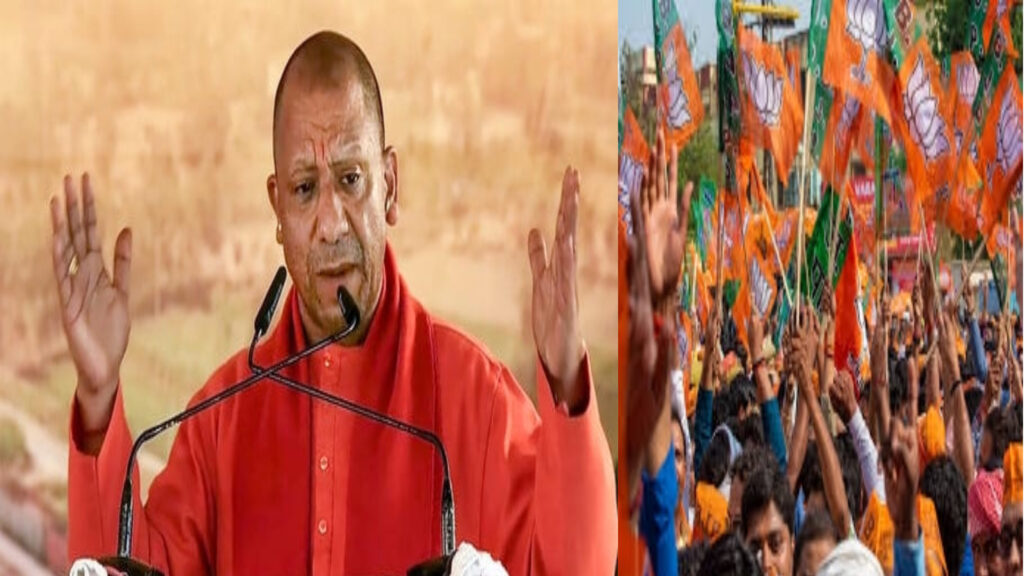During a recent rally in Bulandshahr, Uttar Pradesh, Chief Minister Yogi Adityanath reiterated the Bharatiya Janata Party’s (BJP) rallying cry for the upcoming Lok Sabha elections: ‘Phir ek baar Modi sarkar’, which translates to ‘Once again, a Modi government’. This event followed Prime Minister Narendra Modi’s initiation of the Lok Sabha election campaign earlier that day.
Yogi Adityanath, addressing a large audience, expressed his strong belief in the BJP, led by Prime Minister Modi, securing a third consecutive term in the forthcoming general elections. He emphasized the collective effort required to realize the vision of a developed India.”Before long, the masses will come together to proclaim ‘Once more, a government under Modi’.” This time, the Modi government is set to garner an even greater share of votes than in 2019,” he asserted.
In the preceding week, Yogi Adityanath had launched the BJP’s wall-writing campaign as a prelude to the Lok Sabha elections. The campaign’s slogan, “ek baar phir Modi sarkar, is baar BJP 400 paar”, aims to galvanize party workers. The Uttar Pradesh Chief Minister shared a video on his X (formerly known as Twitter) account, where he is seen painting a lotus – the BJP’s symbol – on a wall in Gorakhpur. He urged the party workers to replicate this act on public buildings, with the caveat that permission be sought before painting on private properties. “Make sure no space is left devoid of our slogans,” he instructed during a media briefing on January 15.
Simultaneously, Prime Minister Modi launched several development projects totaling over ₹19,100 crore in Bulandshahr. This marked his first public appearance in the state following the significant inauguration of the Ram temple in Ayodhya on January 22. At the rally, Modi focused on the importance of farmer welfare and integrating agriculture with technology. He linked the recent ‘pran pratishtha’ ceremony at the Ram temple to the nation’s prestige, underlining a vision to elevate ‘rashtriya pratishtha’.
Modi articulated his vision for the nation, stating, “In Ayodhya, I mentioned in the presence of Ram Lalla that the Pran Pratishtha phase is complete. Now, our goal is to elevate the nation’s prestige. We need to transition from ‘Dev to Desh’ and ‘Ram to Rashtra’… Our objective is to evolve India into a developed country by 2047.”
He also highlighted the significance of Uttar Pradesh in this national development narrative. He lamented that post-independence, development was restricted to certain regions, leaving vast areas, including populous Uttar Pradesh, underdeveloped. This, he attributed to the state’s previous governments, which, according to him, acted more as rulers than administrators.
“This journey towards a developed India cannot bypass the rapid advancement of Uttar Pradesh. After independence, development was uneven, favoring only certain areas, while a significant part of the country, including Uttar Pradesh, remained neglected. This was due to the prolonged period of governance here that lacked the people’s welfare focus,” Modi added.
These developments and statements come in the context of the upcoming Lok Sabha elections, where the BJP, under the leadership of Narendra Modi and with prominent figures like Yogi Adityanath, is making a strong bid for a third term. The party’s campaign focuses on national development, technological integration in agriculture, and a vision for India’s progress by 2047, emphasizing the crucial role of Uttar Pradesh in this grand scheme. The use of slogans and public campaigns like wall-writing are part of the strategy to engage and mobilize supporters across the state and the nation.
The BJP’s election strategy, articulated through slogans and extensive campaigns, reflects a broader vision of national progress and development. The slogan ‘Phir ek baar Modi sarkar’ is not just a call for re-election but a symbol of the party’s commitment to continuity and stability in governance. This message resonates with a significant segment of the Indian electorate, who view the current administration as a catalyst for economic growth and infrastructural development.
Yogi Adityanath’s active participation in the campaign, including his involvement in the wall-writing initiative, demonstrates the regional leaders’ alignment with the national leadership’s goals. His emphasis on the larger vote share that the BJP anticipates this time around indicates a confidence within the party, buoyed by past electoral successes and ongoing development projects.
Prime Minister Modi’s focus on integrating technology with agriculture and his vision for India’s development by 2047 are pivotal to the BJP’s election manifesto. These objectives speak to a future-oriented approach, aiming to modernize India while respecting and preserving its cultural heritage, as evidenced by the emphasis on the Ram temple in Ayodhya.
As the election campaign intensifies, the BJP continues to leverage its achievements and developmental agendas to appeal to a diverse voter base. The party’s strategy, encompassing both regional and national narratives, aims to secure a broad-based support that transcends India’s complex socio-political landscape. The outcome of these elections will be crucial in determining the direction of India’s policies and its position on the global stage in the coming years.

